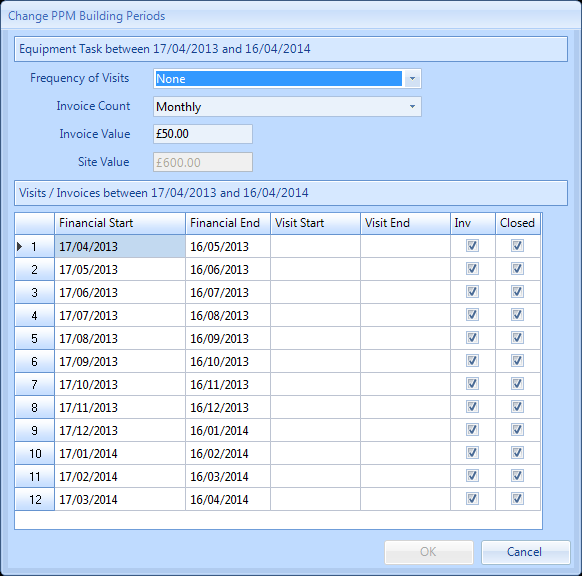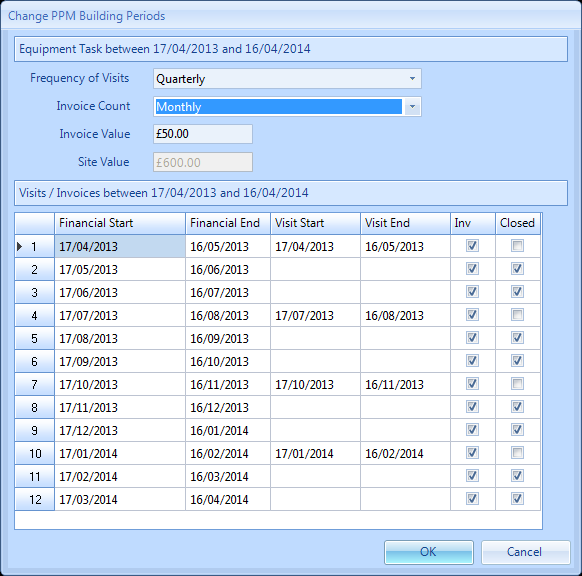PPMs Tab - Change PPM Building Periods



A number of different fields are shown here:
Frequency of Visits is a drop down that allows the User to specify the required number of visits for this Building on the PPM Task. This will have already been configured if the PPM Periods have been setup before the Building was added to the task but can be changed for the Building specifically.
Invoice Count is a drop down that allows the User to specify the required number of Invoices needed for this Building on the PPM Task. This is a separate field because there maybe cases where the Resource needs to Invoice for the work more or less than then number of actual visits. This will have already been configured if the PPM Periods have been setup before the Building was added to the task but can be changed for the Building specifically.
Invoice Value is a currency field that allows the User to enter the Invoice value per visit for the Building. This will have already been configured if the PPM Periods have been setup before the Building was added to the task but can be changed for the Building specifically.
Site Value is a read only currency field that displays the total site value, based on the number of visits and invoice value set for the Building. Amending the Invoice Value or Frequency of Visits will adjust this cost accordingly.
Dynamic Date Updates Supported? indicates (with "Yes" or "No") whether this particular task can have Dynamic Date Updates applied to it. Weekly, Fortnightly, Monthly and Seasonal Frequencies are excluded from Dynamic Date updates.
Exclude from Dynamic Dates Updates is a read only field that indicates (with "Yes" or "No") whether Dynamic Date is supported for this Building on the PPM Task. This can be turned on or off via the Change PPM Building Details or Change PPM Task Details screens.
Partial Periods is a tick box that will allow periods to be generated and visited if they are partial. A Partial Period is Finance Period for a Building that is not the full length. This could be, for example, because the Building has a Start Date that falls in the middle of a Finance Period. Partial Periods will be shown in green.
Next Visit Required By is a slightly different date field in that it can be both configurable and read only. If there are no previous Visits or Certificates relating to this Building or Dynamic Dates is not supported for this PPM Task, then a date can be entered in this field. If a date is entered in here and the changes are saved, the system will then make sure the next visit generated has a Visit End date of the specified date and a Visit Start Date of 30 days prior (or as far back as it can go if there isn't 30 days prior in the Finance Period). This will also update the visits below with these dates.
If there already exists previous Visit or Certificates and Dynamic Dates is supported, the system will automatically put in a date in this field and will not allow it to be changed. The hover over "?" will explain why this field either has date in it and why or why there isn't a date in it and why.
Latest Work Order is a read only field that displays the latest completed Work Order that is used for the calculation of the date in the Next Visit Required By field and the visits below. There is a "View" button which will allow the User to view the WO in the regular WO page. This will only have a WO in it if the PPM Task isn't certificate based.
Latest Certificate is a read only field that displays the latest certificate that was uploaded to the Building on the PPM Task, whether that be via the Building or a PPM, that is used for the calculation of the date in the Next Visit Required By field and the visits below. There is a "View" button which will allow the User to view the documents screen of the Building and in turn, the certificate. This will only appear if the PPM Task is certificate based.
The last part is the Financial Periods Table in the bottom. There are a number of columns within this table, including dates, settings and further details to explain why the dates are what they are, why PPMs have been generated etc.:
- Financial Start Date is a read only date field that shows the Financial Start Date of the finance period
- Financial End Date is a read only date field that shows the Financial End Date of the finance period
- Visit Start Date is a date field that shows the Visit Start Date of the finance period. If Dynamic Dates is on, this field will be read only and the date in it will be automatically calculated. If Dynamic Dates is off, the User will be able to enter in a date so long as it is before the Visit End Date and within the Financial Periods Dates
- Visit End Date is a date field that shows the Visit End Date of the finance period. If Dynamic Dates is on, this field will be read only and the date in it will be automatically calculated. If Dynamic Dates is off, the User will be able to enter in a date so long as it is after the Visit Start Date and within the Financial Periods Dates
- Inv is a read only tick box that shows whether the finance period requires invoicing
- Closed is a read only tick box that shows whether the Building is closed for that finance period
- Cert is a read only tick box that shows whether the PPM generated for this finance period requires a certificate
- Status is a read only field that shows whether the finance period is valid to be visited or not. Note: If a PPM has been generated but the status of the period then becomes Invalid, the system will then automatically cancel this PPM
- Gen. Status is a read only field that shows whether the PPM for the finance period will be generated and if it has been
- Auto Gen. Date is a read only field that shows when the PPM will be automatically generated. This is calculated via system
- Work Order is a numeric field that has a link to the WO generated for the finance period. This will be blank if no WO has been generated
- Summary is a link that shows a more in depth description on why the finance period is in the way it is. It explains things like why it is invalid, why it has generated a WO and why the dates are set as they are
